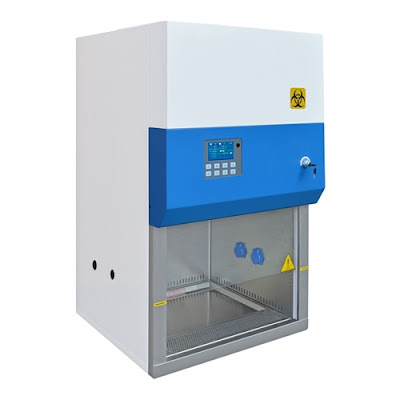Biological safety cabinets (BSCs) play a pivotal role in laboratories across the globe, safeguarding both researchers and the environment from potentially hazardous materials. Global Lab Supply is your trusted partner in procuring top-quality BSCs to ensure your lab's safety and compliance.
Understanding Biological Safety Cabinets
Biological Safety Cabinets, commonly referred to as BSCs, are a cornerstone of laboratory safety. These specially designed enclosures are engineered to protect researchers, samples, and the environment from a variety of biological and chemical hazards, making them indispensable in research, diagnostic, and healthcare facilities.
Types of Biological Safety Cabinets
Class I BSCs: These cabinets provide protection for the operator and the environment but not the sample. They are suitable for handling low- to moderate-risk agents.
Class II BSCs: These offer protection to both the operator and the environment, with an added layer of security for the sample. They are widely used in microbiology, clinical, and pharmaceutical labs.
Class III BSCs: The highest level of containment, these cabinets are entirely enclosed and provide maximum protection for both the operator and the sample. They are used for working with high-risk agents, such as those associated with bioterrorism.
Importance of Biological Safety Cabinets
BSCs serve several critical functions in laboratories:
Personnel Protection
The primary function of a BSC is to shield laboratory personnel from exposure to harmful pathogens and chemicals. The airflow within the cabinet ensures that any potentially hazardous substances are contained, preventing them from escaping into the environment.
Sample Protection
Biological safety cabinets also safeguard the integrity of the samples being handled. Contaminants are prevented from infiltrating the sample, ensuring that research results are accurate and reliable.
Environmental Protection
Beyond safeguarding individuals and samples, BSCs contribute to overall environmental safety. By preventing the release of hazardous materials, these cabinets help maintain the laboratory's clean and safe environment.
Regulatory Compliance
BSCs are essential for compliance with various regulatory standards, including those established by organizations like the Centers for Disease Control and Prevention (CDC) and the National Institutes of Health (NIH). Using BSCs ensures that laboratories meet the necessary safety guidelines.
Selecting the Right Biological Safety Cabinet
Choosing the appropriate BSC for your laboratory requires careful consideration of several factors:
Biosafety Level (BSL)
Determine the BSL of the materials you will be working with. Different BSLs require different levels of containment, and your BSC choice should align with these requirements.
Type and Frequency of Work
Consider the type of work your laboratory conducts and how frequently you'll be using the BSC. High-intensity work may necessitate a more robust BSC.
Space and Layout
Evaluate your lab's space and layout to ensure that the chosen BSC fits comfortably and allows for efficient workflow without compromising safety.
Filtration
BSCs come with various types of filters, such as HEPA and ULPA filters. Ensure that the filtration system meets your specific needs and the regulations you must adhere to.
Manufacturer Reputation
Choose a reputable manufacturer like Global Lab Supply to guarantee the quality and compliance of your BSC. A trusted provider will offer reliable products and excellent customer support.
Proper BSC Operation and Maintenance
To maximize the lifespan and effectiveness of your BSC, it's crucial to adhere to proper operation and maintenance procedures:
Training
Ensure that laboratory personnel are adequately trained in the correct operation and maintenance of the BSC. Regular training and refresher courses can prevent misuse and extend the cabinet's life.
Routine Testing
Perform routine testing, such as airflow and filter testing, to confirm that the BSC is operating within established parameters. This ensures that the cabinet is offering the intended protection.
Airflow Considerations
Be mindful of the cabinet's airflow. Keep it unobstructed, and avoid clutter within the cabinet to maintain consistent airflow and containment.
Regular Cleaning
Maintain a clean and sterile workspace within the BSC. Clean the interior and exterior surfaces regularly to prevent contamination.
Filter Replacement
Change filters as recommended by the manufacturer to ensure the BSC's efficiency. Proper filter maintenance is essential for protection and performance.
Global Lab Supply: Your Partner for BSC Solutions
When it comes to biological safety cabinets, trust Global Lab Supply as your reliable partner. We offer an extensive range of BSCs designed to meet the specific needs of your laboratory. With our commitment to quality and safety, you can rest assured that your BSCs will provide the highest level of protection.
Why Choose Global Lab Supply for Your BSC Needs?
Quality Assurance: Our BSCs are manufactured to the highest quality standards, ensuring the safety of your laboratory and personnel.
Rgulatory Compliance: eWe understand the importance of compliance, and our BSCs are designed to meet or exceed industry regulations.
Customized Solutions: We offer BSCs in various configurations to accommodate the unique requirements of your laboratory.
Expert Support: Our knowledgeable team is ready to assist you in selecting the perfect BSC for your specific application and provide ongoing support.
After-Sales Service: We don't just stop at the sale. We offer comprehensive after-sales service, including maintenance and repairs, to keep your BSCs in optimal condition.
Take Action to Secure Your Laboratory's Safety
Biological safety cabinets are the unsung heroes of laboratory safety. They protect both researchers and the environment from potential hazards, ensuring that the work conducted in the lab remains safe and reliable. To choose the right BSC for your needs, trust the experts at Global Lab Supply. Our commitment to quality, compliance, and customer support makes us the ideal partner for all your BSC requirements.
Don't compromise on safety; act now and secure the safety of your laboratory with the best biological safety cabinets in the industry. Contact Global Lab Supply today to discuss your specific needs and explore our range of BSC solutions. Your research, your personnel, and the environment will thank you for it.





